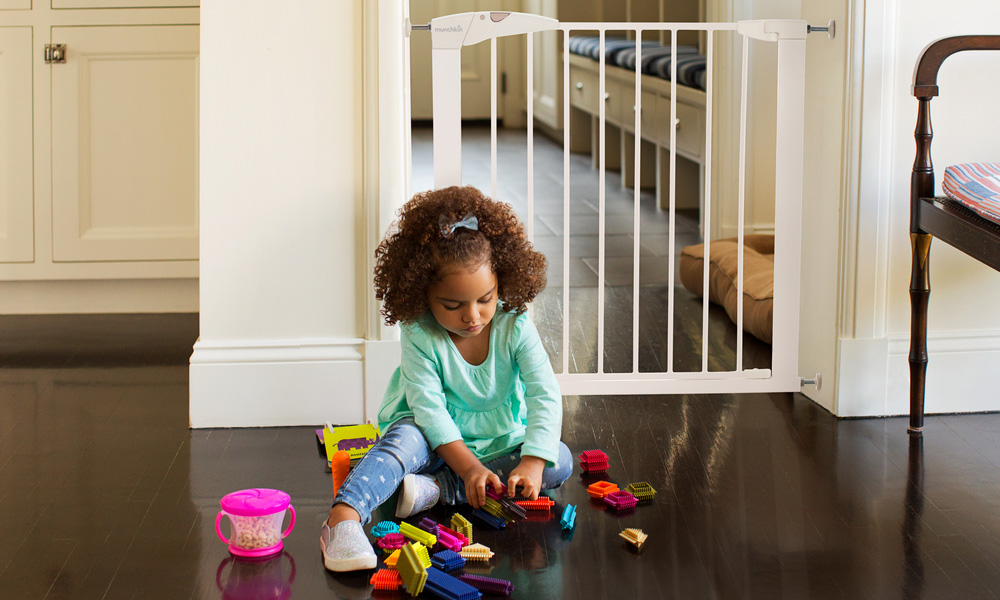Baby is on the move! As soon as your little one starts crawling and becomes mobile, it’s a huge milestone. And while you’ll no doubt be proud parents, it does throw up some safety concerns too. You’ll want the stairs to be out of bounds and likely also want to block unsupervised access to potentially dangerous rooms like the kitchen.
Many parents wonder, “Do I need a stair gate?” and the answer is almost always yes for homes with stairs – and sometimes yes, even for homes without! Stair gates are a lifesaver. But when should you put them up, what are the best stair gates, and at what age do you remove stair gates? Here’s what you need to know about baby gates and stair gates.
Are stair gates necessary?
Stair gates give you peace of mind. You want your baby to crawl (and eventually walk) to explore their surroundings as it’s a vital part of their development. But you also want them to be safe at all times. By blocking access to the stairs and certain rooms in the home with a stair gate, you’ll bring essential safety to your home.
What are the different types of stair gates and how are they installed?
Let’s take a look at the different types of baby and stair gates and explore how to install them. You can choose from the following:
Wall-mounted stair gates: These are attached to your walls on either side of the stairs using screws. They are the most secure form of baby gate, but you will need to drill into your walls which requires a little bit of DIY knowledge – plus there’ll be holes left over when you take them down.
Pressure-mounted stair gates: This type of stair gate attaches to your walls with plates that you fit tight against each wall, with the pressure from the gate holding them in place. They won’t leave holes in your walls and you can adjust the size easily to fit different spaces. You’ll need to check them often however, as they can loosen over time.
You can also choose folding or concertina style stair gates, but we’ll focus here on wall-mounted and pressure-mounted.
If you’re using stair gates to ensure the stairs are out of bounds, it’s recommended to use a wall-mounted stair gate at the top of the stairs to make sure it can’t become dislodged and there’s no bar across the floor which can be a trip hazard. You’ll also need a second stair gate at the bottom of the stairs – either wall-mounted or pressure-mounted is fine. For limiting access to certain rooms in your home, you can opt for either type and it will often depend on the size and dimensions of the doorway.
Curious about how to choose the best stair gates? We’ve put together a guide to help.
When to fit a stair gate?
As a new parent, it’s easy to fall into the trap of expecting your baby to hit certain milestones at specific ages. In reality, every little one is different and it’s about their development rather than age.
With a stair gate, you should have one in place as soon as they start to show signs of crawling. Don’t wait until they can crawl, as it’s best to be prepared in advance. This can happen around seven to 10 months, but remember it’s about your baby’s development, not a number.
When to remove stair gates?
So, are there any rules about when to stop using stair gates in the UK? There aren’t specific rules in place, but there is guidance from the EU that you should do it when the child is two years old. Again, you shouldn’t necessarily be thinking about it in terms of age – it all comes down to their development. If they can safely walk up and down the stairs and you feel confident in their ability to do so unaided, it’s time to remove the stair gate. As a parent, you’ll know when the time is right.
Also, if they can climb over the stair gate or dislodge it, it can pose a risk to their safety – which is when a stair gate becomes more of a hindrance than a help. In the case of dislodging, this can happen sooner with a pressure-mounted stair gate as they are easier to knock down than wall-mounted. It’s something to bear in mind with your choice of baby gate.
What age do you remove stair gates?
If you’re wondering, “How long do you need stair gates?” or looking for guidance on when to remove baby gates, the answer is it all depends on your child. You could have a stair gate in place for as little as 12 months or closer to 18 months. It helps to not think about it in terms of age but in terms of what your child needs.
If it’s still essential for safety around the home and they haven’t started to climb over it then keep it in place for as long as you need. Plus, you’ll quickly get used to opening and closing it every time you go up and down the stairs or into the kitchen. It will feel like second nature in no time!
It’s so important to view your baby as an individual who will take to things at different times. You’ll know when the time is right to get those gates up and to take them down.
Looking for more tips on choosing the best stair gates? Head to our blog or listen to our StrollerCoaster podcast.

Leave a Reply